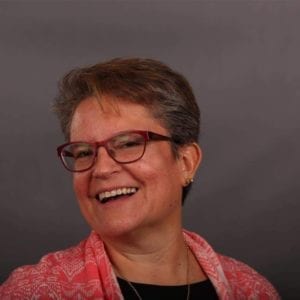My name is Julie Bell. I am someone living with CIDP, Believe or not, it’s changed my life. And today, I consider myself blessed—even despite having a rare and equally chronic disease.
I want you to imagine this; the year is 1990.
I am 28 years old, married with two children and living in San Antonio. We’re flying home from a Thanksgiving visit with my family. As I’m walking through the airport, my dad, who—coincidentally—is a pediatric radiology doctor, notices my gait is off. I really don’t know what to make of it. So he advises me to go ahead and get an appointment with my PCP, which I make for early December. At the appointment, my doctor runs a few tests and asks me to stand on my toes. I can’t do it. “Stand on your heels,” he says. I can’t do that either. Imagine what I’m thinking at this point.
Growing up, I was one of those performer nerds—always acting, always singing, and always dancing. I danced my way through college in fact. I really was convinced that whatever was going on was orthopedic and had no qualms about it. I left my doctor’s office with a referral to see an orthopedic doctor. The next day, I got a call at work from my PCP saying he had made an appointment with a neurologist—for that day.
Understandably, I panicked. Neurologist? Not an orthopedist? What could I really be dealing with then?
The first piece of news I received upon arriving at the neurologist’s office was that my blood test for muscle inflammation had come back elevated. The neurologist wanted to conduct a few tests of his own—EMGs, a spinal tap, and a muscle biopsy. In the end, he narrowed his search down to multiple sclerosis, muscular atrophy, multiple myeloma, and chronic inflammatory demyelinating polyneuropathy, or CIDP. In the end, I was diagnosed with CIDP. I had no clue what that was—what it meant, how it would affect me, if it could be treated. Little did I know, I was actually one of the lucky ones to have been diagnosed so soon. To this day, CIDP is not an easy disease to diagnosis; most people go either undiagnosed or misdiagnosed for years! At that point, though, I did not feel lucky. Not at all.
I was angry. I was depressed. But more importantly, I was scared. I had my pity party. I screamed. I cried. I asked myself, Why me? I feared for my children. They were so young—Tyler at seven months and Emma, just four years old. What was I supposed to do? What were we supposed to do? Thank God for my husband. He saw me out of my “woe is me” attitude and helped me take the bull by the horns. First thing’s first; we research. What I read threw me into a tailspin—to know the reality of what I was up against, that we couldn’t know how quickly my disease would progress, was very overwhelming.
During my research over the next year or so, I came across the CIDP Foundation, where I ended up getting most of my information. I reached out to a doctor who was on the medical board and flew to Dallas to see him. He confirmed my diagnosis, and that’s when I realized there really was no turning back; this was my new reality.
I made an appointment with a hematologist/oncologist back home and began my marathon rounds of plasmapheresis. I went every day for 28 days in a row. In the process, I learned the importance of listening to my body. Doctors are the experts, yes, but no one is going to know my body better than me. I remember a doctor asking me, “How do you feel?” and my response being, “I don’t know. How am I supposed to feel? You’re the doctor.” I have to be in touch with what my body is telling me. How am I feeling? What hurts? What feels good? What are my limitations? Taking this kind of responsibility was difficult at first; there’s definitely a learning curve to living with CIDP.
Over the next few years, I had several exacerbations— each of which put me out of commission for at least a month and left me worse off than I was before. I did my best to push through, but I’d often have to take off from work. I was fatigued, achy, and unable to do certain things. But I stayed in touch with the foundation, researched the newest updates in treatments, and stayed on top of my disease education—and my doctors’ for that matter. I became the expert on my disease, and the educator of those around me.
Nine years into having CIDP, I faced an even scarier battle. In 2004, my husband was diagnosed with pancreatic cancer. This was a hard time. I knew my disease wouldn’t kill me, but cancer? That was a different story for my husband. Cancer flipped the script. By this time, I was experiencing frequent exacerbations, desperately trying to juggle being both the mother and father to our children—10 and 15 years old at the time. Then, in August of 2005, 10 months after his initial diagnosis, my husband lost his battle with cancer and passed away.
Dealing with a tremendous amount of stress and grief, I began to get worse and worse. Drop foot in both feet. Stumbling. Falling. The functionality I had left in my hands deteriorated. I began using ankle foot orthotics on both feet. Funny looking, sure, but I chose to make the best of this situation. I bought crazy knee socks to wear around and embarrass my kids in. Why not go the extra mile and stand out even more?
At the end of 2005, I ended up with another neurologist who mentioned getting me on treatment with Gamunex–C. At that point, I’d been on several IVIG therapies—a couple of which my body hadn’t tolerated all that well. I was more than willing to give this option a chance. And the best part? I saw results. I’m not sure I would have been able to keep my job as a special education teacher for as long as I did without being on treatment. Retiring was one of the most difficult decisions of my life, but now I’m traveling and sharing my story, teaching in a different capacity.
I realized at a symposium I attended once that many people are unaware of not only treatment but also the existence of certain daily living aids—something I, myself, had been using for years. I remember I was in the bathroom one afternoon and a lady with CIDP was complaining about how difficult it is to zip up her pants. I asked her if she’d heard of the “zipper pull.” She looked at me like I was crazy. So I took one out of my purse and showed her how it worked. I’d already been educating doctors at that point; could it be that I had something to contribute to the patient community?
That’s really when I made it my mission to educate— to become a liaison, share my story, and help others learn how to manage life with CIDP. Because why not? I’ve been living with this disease for over 24 years; I’ve come a long way, but I can still vividly remember how lost I felt when I was first diagnosed. One of the hardest things I hear from people with CIDP is that they aren’t able to get on treatment because of the cost. Foundations like the one I work for can’t provide funding. It’s heartbreaking because you and I know how valuable treatment can be. The majority of people living with CIDP are over the age of 60. Many of them don’t have the means to research or spend hours on the phone going back and forth with their insurance company. Some of these people are living paycheck to paycheck. I’ve been there before. Our condition is exacerbated by stress, and each exacerbation sets us backwards. I, for one, can’t afford not to be on treatment.
Public awareness. That’s the key. Educating doctors. There are so many doctors out there who haven’t even heard about this disease, let alone treatment. Imagine how many people are not only walking around with the wrong diagnosis, but being treated for the wrong diagnosis. It’s unfortunate, because imagine what would happen if people with CIDP were diagnosed in a timely manner—if they didn’t have to go years in the dark. Imagine if they got on treatment right away. It starts with awareness and education. That’s where you and I come in.
CIDP is a rare disease, and that’s why the work you do is so important. Great strides have been made to increase awareness, but there’s so much more to do. That’s why I’m out here sharing my story, spreading the word about treatment, and putting a face to the disease. It’s up to you and I to lay the groundwork—to educate the doctors on treatment and the disease itself. Imagine how many lives that could change. Just imagine.
 About the Author: My Name is Julie Bell. I have had CIDP for 24 years out of the 51 years of my life. I am the proud mother of two adult children Emma, and Tyler. I spent 23 years as a Special Education Teacher. In my retirement I enjoy reading and spending time with my 2 grandchildren Ella and Sawyer.
About the Author: My Name is Julie Bell. I have had CIDP for 24 years out of the 51 years of my life. I am the proud mother of two adult children Emma, and Tyler. I spent 23 years as a Special Education Teacher. In my retirement I enjoy reading and spending time with my 2 grandchildren Ella and Sawyer.
Share your stories, thoughts, and hopes with the Patient Worthy community!
For information on CIDP Webinar Wednesdays with a PW collaborator, click here and to register, click here.






